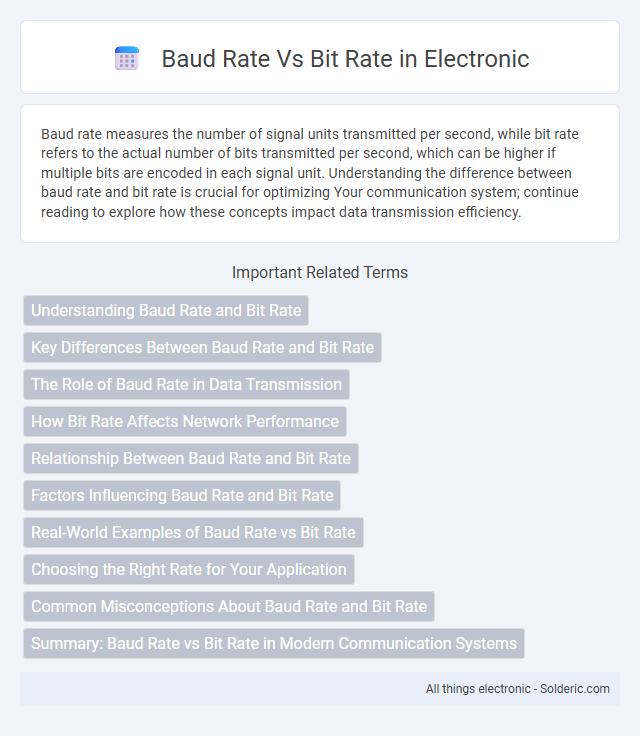Baud rate measures the number of signal units transmitted per second, while bit rate refers to the actual number of bits transmitted per second, which can be higher if multiple bits are encoded in each signal unit. Understanding the difference between baud rate and bit rate is crucial for optimizing Your communication system; continue reading to explore how these concepts impact data transmission efficiency.
Comparison Table
| Aspect | Baud Rate | Bit Rate |
|---|---|---|
| Definition | Number of signal units transmitted per second | Number of bits transmitted per second |
| Unit | Baud (symbols/second) | Bits per second (bps) |
| Measurement | Signal changes or symbols per second | Bits transmitted per second including multiple bits per symbol |
| Relation | May differ when each symbol carries multiple bits | Equals Baud Rate x Bits per Symbol |
| Example | 2400 baud = 2400 signal changes/second | 4800 bps if each symbol encodes 2 bits |
| Use Case | Focus on modulation speed and signaling | Focus on data transfer speed |
Understanding Baud Rate and Bit Rate
Baud rate measures the number of signal changes or symbols transmitted per second, while bit rate quantifies the actual data bits transferred per second in a digital communication system. When each symbol represents multiple bits, bit rate can exceed baud rate, highlighting the importance of modulation techniques like QAM or PSK. Understanding the distinction between baud rate and bit rate is crucial for optimizing bandwidth efficiency and communication throughput.
Key Differences Between Baud Rate and Bit Rate
Baud rate measures the number of signal changes or symbols transmitted per second, while bit rate indicates the number of bits transmitted per second. Each symbol can represent one or more bits, causing bit rate to often exceed baud rate in advanced modulation schemes like QAM or PSK. Understanding the distinction between baud rate and bit rate is crucial for optimizing Your data transmission efficiency and signal encoding methods.
The Role of Baud Rate in Data Transmission
Baud rate represents the number of signal units transmitted per second in a communication channel, directly influencing the symbol rate. Each symbol can encode one or more bits depending on the modulation scheme, making baud rate distinct from bit rate, which measures bits per second. Understanding baud rate is crucial for optimizing data transmission efficiency and adapting communication systems to varying channel conditions.
How Bit Rate Affects Network Performance
Bit rate directly influences network performance by determining the volume of data transmitted per second, impacting overall throughput and speed. Higher bit rates enable faster data transfer, reducing latency and improving the efficiency of real-time applications such as video streaming and online gaming. Network devices and protocols must support elevated bit rates to maintain optimal performance without increased error rates or signal degradation.
Relationship Between Baud Rate and Bit Rate
Baud rate represents the number of signal changes or symbols transmitted per second, while bit rate indicates the total number of bits transmitted per second. Each symbol can encode one or multiple bits, so bit rate equals baud rate multiplied by the number of bits per symbol. Your understanding of their relationship is crucial for designing efficient communication systems and optimizing data transmission speeds.
Factors Influencing Baud Rate and Bit Rate
Baud rate is influenced by the symbol rate and modulation technique, where higher modulation schemes increase bits per symbol, directly impacting the bit rate. Noise levels and channel bandwidth limit the maximum baud rate, affecting data transmission speed and error rates. Efficient encoding schemes enhance bit rate without necessarily increasing baud rate by optimizing the number of bits represented per symbol.
Real-World Examples of Baud Rate vs Bit Rate
A modem transmitting data at 2400 baud can send 2400 signal changes per second, but using techniques like Quadrature Amplitude Modulation (QAM), it achieves bit rates of up to 9600 bits per second by encoding multiple bits per symbol. Ethernet networks commonly operate at bit rates of 1 Gbps while the baud rate is significantly lower due to complex encoding schemes such as 64b/66b. In fiber-optic communication, high bit rates like 100 Gbps are managed with baud rates around 25 Gbaud using advanced modulation formats like PAM4, which conveys two bits per symbol.
Choosing the Right Rate for Your Application
Selecting the appropriate baud rate and bit rate is crucial for optimizing communication system performance and reliability. Baud rate measures symbol changes per second, while bit rate quantifies bits transmitted per second, with modulation schemes allowing multiple bits per symbol to increase bit rate without altering baud rate. For applications requiring high data throughput, prioritize bit rate by choosing advanced modulation, whereas applications sensitive to noise may benefit from lower baud rates to minimize error rates.
Common Misconceptions About Baud Rate and Bit Rate
Baud rate and bit rate are often confused, but they measure different aspects of data transmission; baud rate refers to the number of signal changes per second, while bit rate indicates the number of bits transmitted per second. A common misconception is that baud rate always equals bit rate, which is only true when each signal change carries one bit of information. Your understanding of digital communication improves by recognizing that advanced modulation schemes allow multiple bits per symbol, causing bit rate to exceed baud rate.
Summary: Baud Rate vs Bit Rate in Modern Communication Systems
Baud rate measures the number of signal changes or symbols transmitted per second, while bit rate quantifies the actual number of bits transmitted per second in a communication system. Modern high-speed communication systems often use modulation schemes like QAM and PSK to encode multiple bits per symbol, resulting in bit rates that exceed baud rates. Understanding the distinction between baud rate and bit rate is essential for optimizing bandwidth efficiency and data throughput in digital communication technologies.
Baud rate vs Bit rate Infographic

 solderic.com
solderic.com